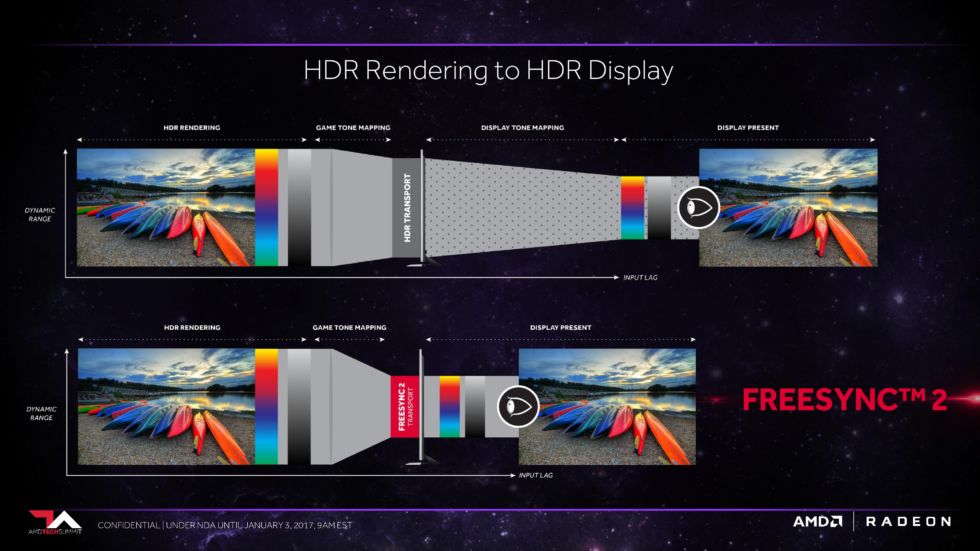-
How HDR on PCs currently works.
-
FreeSync 2 eliminates the second colour mapping step typically required with HDR, thus reducing input lag.
-
FreeSync, AMD's variable refresh rate tech for gaming monitors, now comes in a slicker, and potentially more compelling version. FreeSync 2, which will coexist alongside FreeSync, combines variable refresh rates with the many HDR displays that are expected to make a splash at CES 2017. Not only that, but it promises to fix some of the more pressing problems with its predecessor, including patchy low frame rate compensation (LFC) support and required low latency levels.
At a base level, Freesync—like Nvidia's rival G-Sync technology—synchronises the refresh rate of the monitor with the frames per second output of the game currently being played. This eliminates the input lag associated with using v-sync—which typically locks games to 60FPS, regardless of how quickly the PC is pushing out frames—or playing with v-sync off, which can cause unsightly screen tearing as the game pushes out more frames than the monitor can handle.
The problem with FreeSync compared to G-Sync is that it only works between specified refresh rates—40Hz to 75Hz, for example, rather than any arbitrary figure—and those specified refresh rates can vary from monitor to monitor. This results in problems when FPS performance goes below that window, with FreeSync dropping down to standard v-sync on or off. AMD introduced LFC with its Radeon Crimson software to compensate for this. LFC doubles the frame rate being sent to the monitor in software (G-Sync does this in hardware), in order to keep the perceived frame rate high enough to stay inside the monitor's variable refresh range.
Unfortunately, LFC is only compatible with a handful of FreeSync monitors, those that sport a maximum refresh rate that is 2.5x (or greater) than the minimum variable refresh rate. With FreeSync 2, AMD requires monitor manufacturers to support LFC, thus eliminating the issue.

AMD is also requiring manufacturers to use panels with a minimum allowed dynamic colour and brightness range that's twice as vibrant as standard sRGB displays for HDR compatibility. HDR on PC is a more complex beast than just panel brightness, though. First, a game performs colour tone mapping after an engine renders a scene. Then, when the frame is passed to a monitor, it's tone-mapped yet again to fit the display's supported colour range. That may or may not be the same colour space required by HDR10 or Dolby Vision. This two-stage process takes time and introduces latency.
With FreeSync 2, AMD is removing the second step, connecting the game engine directly to the HDR display. When you plug in a FreeSync 2 display, the display announces its HDR capabilities, and the AMD graphics driver will shuttle that information over to the game engine. This ensures that gamers get the best possible image quality, because the game tone-maps to the screen's native colour space, while also reducing input lag. Unfortunately, it also means that in order for FreeSync 2 and HDR to work, AMD needs the specific colour and brightness capabilities of every FreeSync 2 monitor, while games and video players must be enabled via AMD's API. AMD is going to have to win over a lot of hardware partners to make FreeSync 2 a reality.
Because LFC, HDR, and low latency are requirements of FreeSync 2, AMD is implementing a certification process for displays. FreeSync 2 monitors won't come cheap, then, and right now AMD's not sure about when exactly they will launch. Currently, it's hoping they'll hit the market during the first half of 2017. Samsung has confirmed it will use FreeSync 2 in some of its upcoming monitors.
reader comments
68